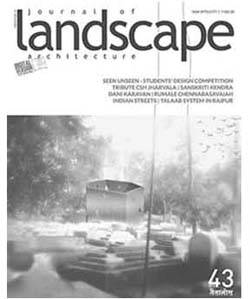Reading books on cities has taught me that town-planners may intervene in landscapes, but that for all the pretentious build-up of deference to ecology and environment, the original great Planner’s wisdom is being increasingly disregarded. Landscapes of rock shaped over centuries are being destroyed, and rivers being channelled by short-sighted modern ‘planners’(as Ravish Kumar gently but forcefully reminded us on NDTV when reflecting on the Chennai floods). A sense of urgency has to be created and sustained, if Indian cities are not to become drowned landscapes. And a crucial role can be played by landscape architects. It is time they grew up, and enlarged their role from that of designing boutique gardenscapes to interpreting and respecting larger landscapes in urban and rural areas, so that viable habitats can be designed. At present, Open space in Indian cities sometimes exists as a one-off showpiece around important government buildings, or to commemorate some short-lived event where the projection of national prestige may be involved. But mostly it as an arena of malignant neglect that is always vulnerable to being usurped through the subterfuge of land-use changes or other kinds of abuse. Rarely is it an area of design, even though we experience and see the city from its outdoor spaces, and the quality of those spaces determines what we think of that city. (Mohammad Shaheer, The Wall Street Journal, India, March 15, 2011)
At a time when Chennai has become a metaphor for the murder of our cities by callous builders (an innocuous name for a dangerous modern tribe), I would like to draw attention to the writings of Mohammad Shaheer, a visionary landscape architect*. In the prevailing sound and fury, the competitive cliché and slogan, his is a voice of sanity. It draws the reader into appreciating the land, the people and the histories of our country, into re-awakening the sense of joy in nature which is the essence of worship. An architect who watches his building rising is tempted to see himself for one moment as God. The landscape architect imitates God. They can also be excited by Zen philosophy, by the pure beauty of mathematics, learn to be historians who can read the palimpsest, artists who use colour and texture, music-makers whose creations weave harmonies of sky and land.
And some of them can articulate an appreciation of beauty and an awareness of what created it, can effortlessly refer to films, books and paintings, and weave it all into the written word. And do this in a tone of understatement, of tentativeness, and with a continuous appreciation of other people’s points of view.
‘The making of gardens and landscapes has an ontological purpose. They exist as abstractions as well as actualities, and in both incarnations they tell us something about our place in the universe’ Shaheer, (‘A View from the Window’).

